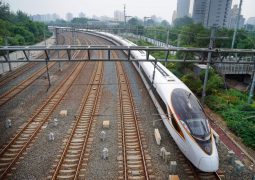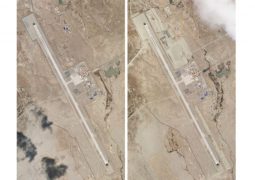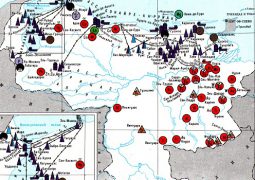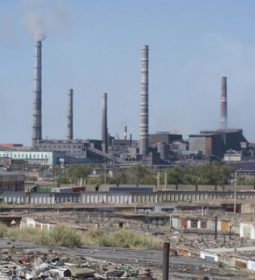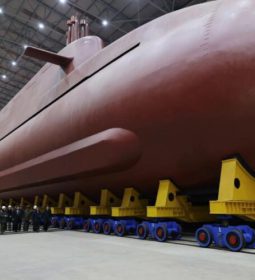Ethiopia’s 6000 MGW and 60 bn tons HPS: Water crisis in North Africa dampens future

Death on the Nile Haunts Ethiopia’s Rebirth

The day Simegnew Bekele was found dying at the wheel of his Toyota Land Cruiser in central Addis Ababa—doors locked, engine running and a bullet wound to his head—he had left home holding a plane ticket and a packed bag.
The plan on that July afternoon a year ago was to return to the construction site of the vast hydroelectric dam that Simegnew had been overseeing since 2011, according to his mother-in-law, Membere Mekonnen. The project on the Nile had made its chief engineer a national hero. His was the public face of plans for a new Ethiopia that would no longer be known for famines and war, but as Africa’s powerhouse—literally.
Membere, like many Ethiopians, still doesn’t believe the police finding of suicide. “Why do you buy a ticket and pack your bag to go, if you are going to shoot yourself?” the 72-year-old said in an interview at her home in the capital, where she now cares for the youngest two of the three children he left behind.

Simegnew Bekele at the Grand Ethiopian Renaissance Dam construction site. Photographer: Gioia Forster/Picture Alliance via Getty Images
Whoever pulled the trigger, Simegnew found himself in the eye of multiple political storms that are still today battering one of Africa’s largest infrastructure projects: the Grand Ethiopian Renaissance Dam (GERD). A year after his death, a symbol of Ethiopia’s prosperous future risks becoming a reminder of the country’s struggles to shake its turbulent past.
Egypt has vigorously opposed the dam’s construction, due to concerns the project could reduce the supply of water downstream, at one point even threatening war. More than 80% of Egypt’s Nile water supply originates in the highlands of Ethiopia. But unprecedented access to officials and engineers running the dam project suggest the greatest risks to Ethiopia’s hydro-powered transformation come not from Egypt, but from internal disputes surrounding a leadership change in Addis Ababa just three months before Simegnew’s death.
The country’s prime minister, Abiy Ahmed, has ushered in new, more market-based ideas on how to run the economy. The previous government’s use of the dam as a training project for Ethiopia’s state-owned military industrial champion caused delays, and its removal over alleged quality failures and incompetence could cause more. Just days before Simegnew’s death, Abiy warned that on current progress it could take another decade to finish the dam, according to Ethiopian media reports.
Heightened tensions between the country’s complex patchwork of ethnic groups also threaten the project, pulling at the seams of a nation stitched from the fertile highlands and arid lowlands of a former empire. Abiy is from the country’s largest (but historically subordinate) Oromo ethnic group. His arrival displaced 27 years of ascendancy for Tigrayans, who in turn ended centuries of preeminence for Amharas.
Tale of Highlands and Lowlands
4.26M
people in need
2.21M
1.26M
1.49M
FOOD INSECURITY
MALNUTRITION
DISPLACEMENT
MORBIDITY FROM
INFECTIOUS DISEASES
Number of armed conflicts
Number of displaced people
1,200
4M
900
3
The increase in internally displaced people followed an explosion of ethnic conflicts since 2017
600
2
300
1
0
0
’97
’18
’97
’18
Almost three million Ethiopians were driven from their homes by conflict last year, according to the Internal Displacement Monitoring Center, the highest number worldwide. In June, an alleged coup attempt in the northern Amhara province left its president and Ethiopia’s top general dead. Amhara nationalists lay claim to the territory on which the Renaissance dam sits, in neighboring Benishangul-Gumuz, and where Abiy told parliament another coup had been planned to follow the one in Amhara.
Ethiopia’s “nationalities have been fighting against central governments for over 80 years,” said Sebhat Nega, a founder of the Tigray People’s Liberation Front that led a rebel takeover in 1991 and has now been marginalized under Abiy. If constitutional order isn’t restored, he added, “the Balkanization of Ethiopia is inevitable.”
The dam will be completed eventually, and there’s nothing inevitable about Ethiopia’s fragmentation. Yet Simegnew’s death brought public frustrations to a head. Thousands turned out to his funeral to demand answers on how he died, clashing with police. Conspiracy theories still swirl as to who might have killed the engineer.



As the grand name suggests, it’s hard to overstate the importance of the “Renaissance” dam to Ethiopia—Africa’s most populous nation after Nigeria—or the burden that rode on the 54-year-old engineer’s shoulders. When the government ran short of funds to pay construction costs that are certain to exceed the dam’s original 3.4 billion-euro ($3.8 billion) price tag, ordinary Ethiopians stepped in with donations. Civil servants were volunteered to give a month’s salary.
Despite a decade of annual growth rates as high as 10%, and a pipeline of major Chinese investments, Ethiopia remains a desperately poor country with a GDP per capita below $1,000. Once the dam’s 16 turbines are switched on, the 6,000-megawatt facility will increase the country’s supply of electricity by as much as 150% at a stroke. That will bring power to many among the two thirds of Ethiopia’s roughly 100 million population who have none, according to Minister for Water, Irrigation and Electricity Seleshi Bekele.
Ethiopia GDP
Famine kills
estimated 1.2 M
$2K
Abiy Ahmed becomes
prime minister
Peace agreement
with Eritrea
1
GERD dam
construction begins
Eritrea declares
independence
Civil war ends
0
’81
’18
Then there’s the wider effect on the mainly agrarian economy and the region. China has agreed to build a $1.8 billion power grid to support a Chinese-built and funded high speed railway, currently plagued by power cuts, as well as to 16 special industrial zones. Electricity exports to Ethiopia’s neighbors will earn desperately needed hard currency.
Those interconnections could in turn help tame the seemingly perpetual cycle of poverty, famine and violence that has long blighted the Horn of Africa, from Somalia, to Eritrea, to Sudan and South Sudan.
“This is more than a dam, more than a job,” said Yared Girma, one of Semegnew’s deputies. “It’s the pride of Ethiopia.”
The Nile Network
Nile basin
Nile river and tributaries
Major dam
Alexandria
Suez
Cairo
Main
Nile
Assiut
EGYPT
Aswan
Red
Sea
Wadi Halfa
Kajbar
Bur Sudan
Main
Nile
Shereik
Merowe
Atbara
(Tekezze)
ERITREA
Khartoum
Asmara
Upper
Atbara
SUDAN
Sennar
El Obeid
White
Nile
Gulf of Aden
Roseires
GERD
Blue Nile
(Abay)
Addis Ababa
Bahr el
Zeraf
ETHIOPIA
SOUTH SUDAN
Juba
Albert
Nile
Karuma
DRC
KENYA
UGANDA
Nalubaale
Kampala
Indian
Ocean
Lake
Victoria
Nairobi
Kigali
RWANDA
Bujumbura
300 mi
BURUNDI
TANZANIA
300 km
The dam sits between the last two shoulders of mountain where the Nile sweeps down from the highlands of Ethiopia, about 20 kilometers (12 miles) from the border with Sudan. Behind it, thousands have been displaced to make way for a reservoir 246 km long. The bone-white cement wall, up to 170 meters high and 1.8 km long, is complete but for the center section.
By now, the project is five years behind schedule and counting. At least 60 trucks from Salini Impregilo SpA, the contractor for the civil engineering part of the project, stand idle. The Italian company is demanding compensation and says it paused work on the concrete structure in October. On a recent day, a Nile crocodile swam slowly upstream toward the relative quiet of the construction site.

Workmen’s overalls hung out to dry at one of the dam’s two powerhouses. Photographer: Zacharias Abubeker/Bloomberg
Simegnew had been due to fly back here the day he died, together with a team from Metals and Engineering Corp., or Metec, the military-run Ethiopian conglomerate that was in charge of the power generation side of the dam’s construction. Within months, Metec had been removed from the project and broken up. Fourteen of the retired and serving officers in its senior management are now either in jail or fugitives, accused of corruption in different parts of the business.
New Metec management installed by the government has accused the company of failing to meet any of its contractual obligations at the dam, despite receiving almost two thirds of the money due. Seleshi, the water minister, declined to comment on the company’s removal, but said he expected the dam to be complete and the reservoir full no more than seven years after filling begins in 2020.
Metec’s work has been redistributed to foreign sub-contractors, including China Composites Group Corp., Sinohydro Corp. Ltd. and GE France SASU. Standing next to a faded sign that reads “Metec means dynamism,” GE France site supervisor Philippe Robard rolled his eyes when asked about the company’s contribution to the project. “The first two units should have been working by now,” he said, speaking of the turbines.
Italian contractor Salini said in an emailed response to questions that delays caused by Metec were mainly due to “their total lack of experience in the execution of works of this nature and magnitude.”
Down in the powerhouse at the dam’s base, Indian welders are assembling the 7 meter diameter pipes that will direct water onto those two turbines. Once complete, they’ll be drowned in concrete to prevent vibration, a rod fixed to the center of each, and a pair of 800 ton rotors lowered onto those. The same procedure will then follow for the other 14 turbines.
The new chief engineer, Kifle Horo, shared the job with Simegnew back in 2011 when the project started. He says he was removed after clashing with Metec over its proposal to change the dam’s design to increase the headline generating capacity.
The generals, Kifle said, weren’t engineers and didn’t understand that this would simply add unused capacity and cost. The dam’s potential for producing energy over a year is fixed by the volume and depth of water in its reservoir. Extra megawattage just allows the same quantity of electricity to be produced in shorter bursts.
“It’s meaningless,” Kifle said of Metec’s design change. The aim is now to start filling the reservoir next June and complete construction in 2022, though some of the previous work needs to be undone first. “There are a lot of uncertainties, because Metec erected two bottom outlets and, due to quality reasons, we have already started to remove these.”


Top: The spillway that allows water to flow out of the reservoir when it overfills. Bottom: Part of piping that will direct water into the turbines. Photographer: Zacharias Abubeker/Bloomberg
The man responsible for Kifle losing his tussle with Metec—and to whom Simegnew reported—was among the most powerful officials in Ethiopia’s former government, Debretsion Gebremichael. An electrical engineer by training, he said he persuaded the rest of the government to approve the design change, arguing the addition of a turbine would reduce operating costs.
Sidelined in Addis Ababa by the political changes that culminated in Abiy’s appointment as prime minister, Debretsion is now acting head of the local government in his native Tigray province, as well as chairman of the TPLF. In an interview at his office in Mekele, the regional capital, he described Simegnew as “a victim.”
Metec was added to the project for three reasons, according to Debretsion. The first was to build the company into a state-led equivalent of South Korean chaebols such as Samsung and Hyundai. Ethiopia aims to become a giant of hydropower exports and the idea was to train up local engineers who would be able to take the lead in building future dams. It was always understood that using a domestic company would take longer and that gaps in expertise would have to be filled, the Tigrayan leader said.
A second goal was to reduce the dam’s financial burden, which is being paid for without the help of international lenders. The government decided to hive off roughly 1 billion euros from the bill, giving that work to Metec to execute in local currency with (dramatically cheaper) local labor. The final motivation, according to Debretsion, was to reduce the number of foreign companies that might pull out under Egyptian pressure.


Welders working on the turbine assemblies. Soldiers at Metec’s open air cafe on the construction site. Photographer: Zacharias Abubeker/Bloomberg
“Stripping Metec out is completely against the original strategy,” and against Ethiopia’s long-term economic interests, said Debretsion. Simegnew, he added, believed in the approach. “He said we have to support these guys, so that they will finish this.”
Metec scoured Ethiopia’s universities for engineering graduates to work at the dam. Among them were eight interviewed for this article, all now aged 30 or younger. Until they were let go last year, they were on salaries of $163 per month or less. Now they are jobless, their resumes poisoned by association with Metec’s damaged brand.
Taye Shiferaw was 23 and fresh out of college with a degree in manufacturing when he started work at the dam four years ago. He was made team leader for quality control on the linings Kifle is concerned about, some of the dam’s most sensitive parts. If they were to leak, the immense pressure of the water and sediment rushing through the voids could erode concrete at the base of the dam and cause its collapse.
According to Taye, the military officers in charge—his boss was a major-general—couldn’t understand what the engineers reporting to them were talking about. Handed a technical report, they would just reply “Go on! No problem!” he said. Anyone who insisted on a quality control issue risked being accused of membership in the Oromo Liberation Front, at the time listed as a terrorist organization.
Many of those officers—and of the military’s top brass in general—were Tigrayans. By now, Mekele feels like a fortress for a government in exile, with Tigrayan ex-government officials and Metec executives frequenting the local Planet Hotel, and some spending evenings at the Mountain Lounge bar downtown.
At the hotel, an army major describing himself as one of Metec’s founders fiercely disputed accusations of incompetence and waste. He cited the dam’s expanded hydro-power design as proof of the company’s technical abilities. His friend, a Metec colonel with a baseball cap pulled low over his face, had just stopped in. He said he was wanted by police in Addis Ababa and was hiding in the bush outside Mekele. He came to the hotel to shower and brush his teeth.
Delays and technical difficulties arise in large infrastructure projects all over the world, said the colonel. “In my view, it was a blindly political decision” to remove Metec, and one designed to discredit Tigrayans in the former government and military, he said. Neither officer wanted to be named, for fear of repercussions from the capital.
Getachew Reda, a Planet Hotel resident and politburo member in the fragmenting coalition of ethnically based parties that has ruled Ethiopia since 1991, was to be found at the Mountain Lounge. A huge bottle of Johnny Walker Black Label whisky was draining fast on the shared table. At one point he was pulled away to dance to the Tigrayan fighting song and anthem, “We Shall Overcome.”
The break-up of Metec was also about ethnic politics, according to Getachew. Of the 14 Metec officers charged with corruption, a majority are Tigrayan. “An ethnic purge is taking place, that much I can tell you,” he said.

Membere Mekonnen, at her home in Addis Ababa. Above her, a photograph shows Simegnew with his family. Photographer: Zacharias Abubeker/Bloomberg
Membere Mekonnen doesn’t concern herself with such high politics. She just remembers how Simegnew’s cell phone rang without pause the day before he died, leaving him without a moment to talk to his younger son, 16, and daughter, 9. He was depressed and clearly under immense pressure that night, but he didn’t kill himself, she insists, dismissing a police statement that he had left behind a note. Police also said he called his secretary before he died, asking her to “take care of my children.”
According to the police, Simegnew shot himself with his own gun because of pressure over delays in the dam’s construction and the emerging fact that Metec had spent more of the nation’s money than its progress could justify. He didn’t die immediately. The police said they broke a window in the attempt to get him out. In his note, according to police, Simegnew said he wanted to leave the country, but was worried he couldn’t explain himself to the Ethiopian people.
Membere is waiting for her daughter, Simegnew’s estranged wife, to secure asylum in Canada, after which the children will be sent to join her. Theirs hasn’t been an easy story. Their mother left home and, before he died, their father was so busy with dam business he sometimes left them waiting in vain after promising to visit.
“He loved that dam more than his children, because he thought it would change Ethiopia,” Membere said. Like so many others, she never questions the value or necessity of the dam itself. “We lost a hero.”
- Previous 6 Bombs hit Bangkok during major security meeting
- Next New Geopolitical Host Spot in East Timor. It wants to tap oil and gas near Australia, so why is it courting China?








